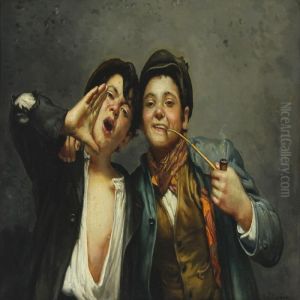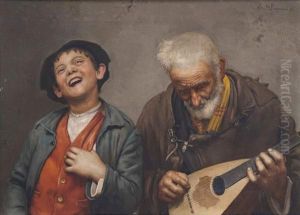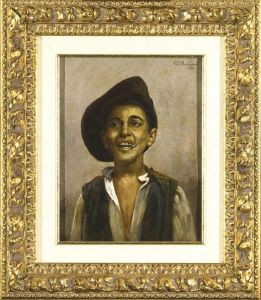Vincenzo Busciolano Paintings
Vincenzo Busciolano was an Italian painter and sculptor, born in 1867 in Bitonto, a historic city in the province of Bari, in the southern Italian region of Apulia. His artistic journey began in the vibrant cultural environment of Italy at the time, which was a crucible for various art movements and styles. Busciolano's work is often associated with the Symbolist movement, which sought to express the idea that behind the visible world there is a more profound and esoteric reality that can only be accessed through symbols, myths, and dreams. His oeuvre includes a range of subjects, from mythological and religious scenes to portraits and landscapes, all marked by a distinctive use of color and form that sought to evoke rather than depict reality.
Busciolano received his early education in Italy before further honing his skills and artistic vision through travels in Europe, which was a common practice among artists of his generation. These experiences exposed him to a variety of artistic influences and movements, enriching his work and allowing him to develop a unique style that blended elements of Symbolism with those of other contemporary movements. Despite the popularity of Futurism and other avant-garde movements in Italy during his lifetime, Busciolano remained committed to his vision, exploring themes of myth, religion, and the human condition through a symbolist lens.
Throughout his career, Vincenzo Busciolano participated in numerous exhibitions, both in Italy and abroad, gaining recognition for his contribution to the Symbolist movement. His works are characterized by their intricate detail, vivid coloration, and the often dreamlike quality of their subjects. Busciolano's artistry was not confined to painting alone; he was also accomplished in sculpture, where he applied his symbolist ideas to three-dimensional forms, creating works that resonate with the same mystical and introspective qualities found in his paintings.
Despite his contributions to the art world and the unique place he occupies within the Symbolist movement, Vincenzo Busciolano remains a somewhat enigmatic figure, less widely known than some of his contemporaries. Nonetheless, his work continues to be appreciated by art historians and collectors who recognize the depth and originality of his vision. Vincenzo Busciolano passed away in 1946, leaving behind a body of work that continues to inspire and intrigue with its mystical beauty and symbolic complexity.


